The TPU shoe material foam thick plate production line uses thermoplastic polyurethane elastomer (TPU) as raw material and produces thick plate materials with excellent performance through foaming technology, which are widely used in the field of shoe materials. The following analysis will be conducted from the aspects of production technology, equipment composition, performance advantages, application fields, and development trends:
1、 Production process
Raw material preparation: TPU particles need to be dried in advance, with moisture controlled below 0.05% to ensure the purity of the raw materials. Different grades of raw materials need to be stored separately, especially colored and transparent materials, which need to be isolated, and the particle size should maintain a uniformity of 2-3 millimeters.
Mixing: The amount of foaming agent is usually 3% -8% of the raw material, and ultrafine talc powder as a nucleating agent accounts for 0.5% -1%. Attention should be paid to matching the decomposition temperature of the foaming agent with the melting temperature of TPU. Chemical foaming agents such as azodicarbonamide are commonly used. The mixing equipment should operate at a low speed of 30 revolutions per minute to prevent premature reaction.
Extrusion molding: The temperature of each section of the twin-screw extruder rises step by step, with the feeding section at 160 ℃, the melting section at 180 ℃, the homogenization section at 200 ℃, and the head temperature controlled at 190 ℃± 2 ℃. The die head pressure is maintained at 8-12 MPa, and the screw speed is adjusted according to the production volume. For conventional production, it is maintained at 60-80 revolutions per minute.
Foaming: The gas saturation pressure needs to reach 6-8 atmospheres, with a holding time of 15-25 minutes and a pressure release rate controlled within 0.5 seconds to quickly release pressure and form a uniform closed cell structure. The mold temperature should be maintained at 40-50 ℃, as excessive temperature can cause the collapse of the pores.
Stabilization treatment: The newly formed foam should be immediately sent to a 60 ℃ constant temperature chamber for aging for 24 hours, allowing residual gases to slowly release. Conditional enterprises can use vacuum aging chambers to shorten the aging time to 8 hours and control the thickness shrinkage rate within 3% to be considered qualified.
Cutting and quality inspection: The vibrating knife is suitable for cutting thin sheets below 10mm, and for thicknesses exceeding 20mm, a water-cooled circular saw must be used with a feed rate of 2 meters per minute. Quality inspection includes density testing (allowable error ± 0.05g/cm ³), compression permanent deformation testing (72 hour recovery rate greater than 85%), rebound testing (500mm free fall rebound height not less than 70% of the original height), etc.
2、 Equipment composition
Raw material pretreatment equipment: used for drying, mixing and other pretreatment of TPU particles to ensure the purity and processing performance of raw materials.
Twin screw extruder: The core equipment is responsible for heating and melting the pre treated TPU raw materials, and extruding them into continuous sheet shapes through the pushing effect of the screw.
Mold: Installed at the outlet of the extruder, used to determine the cross-sectional shape, size, and thickness of the sheet.
Cooling device: using air or water cooling methods to quickly cool and shape the extruded sheet.
Cutting and trimming equipment: Cut the cooled sheet into the required length and width, and perform edge trimming.
Quality inspection and packaging equipment: Conduct quality inspections on the produced boards, such as thickness, flatness, transparency, etc., and package and store qualified boards.
3、 Performance advantages
Lightweight and high elasticity: TPU foam thick plate has low density and excellent elasticity, which can effectively reduce the weight of the sole and improve wearing comfort.
Wear resistant and flexural resistant: TPU material itself has high wear resistance and flexural resistance, and can maintain good performance even after foaming, extending the service life of the sole.
Environmentally friendly and recyclable: TPU is a renewable and recyclable material that is environmentally friendly and in line with the concept of sustainable development.
Good breathability: TPU soles have good breathability, which can help keep feet dry and avoid stuffiness.
4、 Application Fields
Sports shoes: widely used as midsoles and insoles in sports shoes such as running shoes and basketball shoes, providing good cushioning and rebound effects.
Casual shoes: Used for the sole of slippers, sandals, and other casual shoes to enhance wearing comfort.
Special shoes: suitable for special shoes such as hiking shoes, safety shoes, etc. that require high shoe sole performance.
5、 Development Trends
Application of Supercritical Foaming Technology: Adopting Supercritical Carbon Dioxide Foaming Technology, it has better environmental performance and stable foaming, but the equipment investment is relatively high.
Process optimization: By precisely controlling parameters such as temperature, pressure, and time, the quality of foaming and production efficiency can be improved.
Material innovation: Develop new TPU materials with higher performance to meet the needs of different shoe materials.









